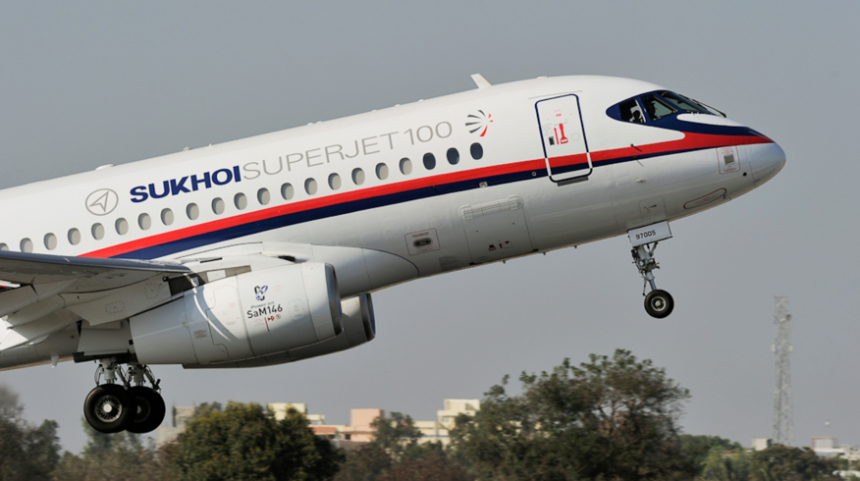The visit of the Russian President Dmitry Medvedev in Italy on Feb. 16 – 17, 2011, provided the opportunity to discuss the cooperation of the two nations various fields.
Among the other topics (energy in particular) the Russian delegation has asked Italy’ support to promote its SuperJet SSJ100 to new customers and to Alitalia, the Italian flag company, that was among the possible customers, until in December it announced the purchase of 20 Embraer (15 ERJ-175 and 5 ERJ-190) to replace and strenght its fleet of E-170 and CRJ-900 regional jets (the latter, inherited from Air One).
The SuperJet is the first major passenger aircraft produced in Russia since the collapse of the Soviet Union and its the first of a new family of regional jets. It is produced by the Sukhoi Civil Aircraft, of which Italy’s Finmeccanica owns 25%.
It rolled out on Sept. 26, 2007 in Komsomolsk-on-Amur where it performed its maiden flight on May 19, 2008. In 2007, Alenia Aeronautica, a Finmeccanica company, and Sukhoi Holding formed SuperJet International, a joint venture (51% – Alenia Aeronautica, and 49% – Sukhoi Holding) based in Venice, responsible for marketing, sales and delivery in Europe, America, Africa, Japan and Oceania as well as for worldwide logistic support for the Superjet 100.
On Jan. 28, 2011 it was granted the Type Certification by the IAC AR, the Russian certification authority, and it’s due to get the European certification by the year-end. Even if SuperJet hopes Alitalia hasn’t lost interest in the SSJ100, that cost less than the Embraer E-series and Bombardier CRJs, the regional contest seems to be gone: according to what Alitalia CEO Rocco Sabelli said, at the end of the press conference in which Alitalia announced its return to China by means of a code sharing agreement with China Eastern airlines (4xwk FCO-PEK with AZ A330 and 4xwk FCO-PVG with MU A340), the Italian flag company has already made some initial payments and it is currently building the package of leasing.
The first aircraft should be delivered by the next summer and the first five by the end of 2011, with the remaining 15 in 2012.
Most probably, the main cause for turning down Sukhoi’s proposal to opt for the Brasilian planes (costing, yearly, some 200K – 300K Euro more than the Russian ones – money that should be recovered “elsewhere” within the order) was the fact that the SSJ100, at the time Alitalia made its decision, had yet to pass certification with Russian and European civil aviation authorities while its competitor was almost ready for delivery (even if it must be underlined that SuperJet affirmed that the certification schedule fitted perfectly with the Alitalia requirement to receive the first aircraft within summer 2011).
Whatever the Alitalia future plane may be, the SSJ100, that attended the Aero India 2011 at Bangalore, India (where the above pictures were taken by Katsuhiko Tokunaga) will be an important challenger for both Embraer E-Jet and Bombardier CRJ that could lose a large slice of their once exclusive market as SuperJet makes inroads into the Western world of “regionals”. That’s why Italy (airlines and industry) is looking at this aircraft with interest.
Another important topic that was discussed by the Russian delegation in Italy, was the agreement on the transit of military personnel, ammunition and equipment destined to the Italian contingent operating in Afghanistan through the Russian airspace. So far, as explained in the article “Italian shuttle flights to Kabul” troops and supplies to Herat and Kabul, has transited through Middle East.
The heavier material is carried by ships that reach Pakistan and then proceed to destination by means of ground transportation, while military vehicles, helicopters and ammunitions are carried by the C-130Js of the 46^ Brigata Aerea of the Aeronautica Militare (Italian Air Force, ItAF), based in Pisa, or on board the Antonov AN-124 leased by the Ministry of Defence (whose cost is on average 500K Euro per flight, according to the Sole 24 ore, the main independent Italian economic newspaper).
Military destined to the Afghan theatre use civil charter flights that carry them to Al Bateen, in Abu Dhabi, where they can board on one of the shuttle flights of the local Task Force Air of the ItAF which connect the intermediate base in the United Arab Emirates with the final destination in Afghanistan. With the new agreement, supplies and troops will be able to reach Herat with no stop flights from Italy, saving the cost for keeping the C-130s at Abu Dhabi (26 milion Euro were the out-of-the pocket expenses in 2010, according to the Sole 24 ore).








